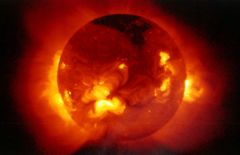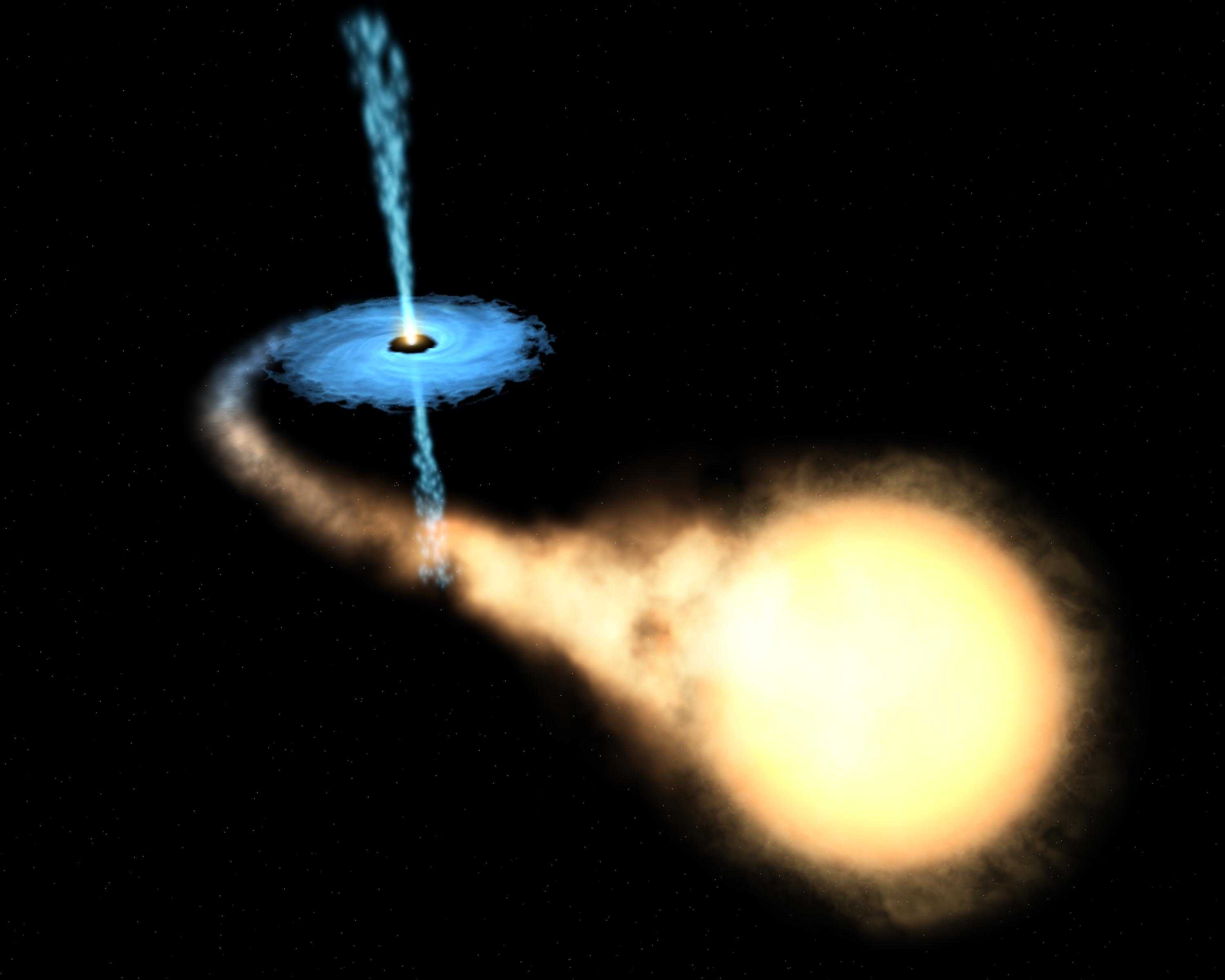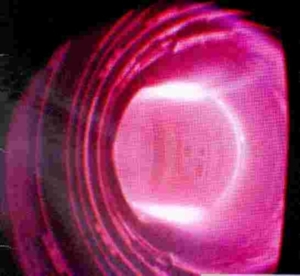Kinetic Plasma Turbulence
View this page in Romanian courtesy of azoftPlasma is a ubiquitous form of matter in the universe. It is nearly always found to be magnetized and turbulent. One must understand this behavior to interpret a large body of astronomical observations. Examples include turbulence in the interstellar medium, which is stirred by violent events like supernova explosions; turbulence in accretion flows around stars and compact objects; and turbulence in the solar wind streaming outward from our Sun. Common to these turbulent systems is the presence of an inertial range, an extent of scales through which energy cascades from the large scales at which the turbulence is stirred to the small scales at which dissipative mechanisms convert the turbulent energy into heat. The turbulence traditionally studied in fusion plasmas, on the other hand, is caused by gradient instabilities—consequently, the driving occurs at the same scale as the dissipation mechanisms act, so no inertial range arises. But in the burning plasma of the International Thermonuclear Experimental Reactor (ITER), hot alpha particles generated by the fusion reaction may drive Alfven wave turbulence at a scale substantially larger than the kinetic scales of the thermal plasma, leading to the development of an inertial range. Thus, the flow of turbulent energy in inertial range turbulence not only strongly affects the observable characteristics of many astrophysical plasmas but also may significantly influence the capture of fusion energy in a burning plasma.
At large scales, magnetized plasma turbulence is well-described by magnetohydrodynamics (MHD), which describes the plasma as an electrically conducting fluid. Within the context of MHD, there has been significant progress in understanding how eddies at large scales break up into smaller and smaller eddies, but important questions remain regarding the nature of turbulent fluctuations at scales smaller than a collisional mean free path. At these scales, fluid theories such as MHD cannot be used to describe the dynamics or to compare with observational or laboratory data—the dynamics instead must be described by kinetic theory. Because the energy of the turbulent motions is converted into heat at these small scales, important macroscopic properties (such as the temperatures of the various plasma components) are determined by microscopic physics. For example, matter spiraling into a black hole converts a tremendous amount of gravitational potential energy into heat. The radiation that is emitted from the hot, magnetized plasma is a strong function of the black hole properties and of the character of the small-scale plasma fluctuations which determine the plasma heating. To understand X-ray observational data from Chandra, one must characterize the small-scale, kinetic plasma turbulence. In the solar wind and in the interstellar medium, there are similar unsolved, interesting problems. However, in these cases, there are also direct observations of the small-scale fluctuations, presenting concrete opportunities for testing insights which might be gained from theory and simulation. Comprehensive, in situ satellite measurements of all aspects of the electromagnetic fluctuations in the solar wind offer particularly exciting possibilities for confronting and testing our understanding of kinetic plasma turbulence.
The Fundamental Plasma Physics of Kinetic Plasma Turbulence
I will provide here a simplified blueprint of the physical mechanisms guiding the flow of energy in kinetic plasma turbulence. It is important to emphasize that many of the mechanisms described below are not well understood. Here I aim only to paint the overall picture in broad strokes; a detailed discussion of the many uncertainties is found in Inertial Range Turbulence in Kinetic Plasmas, Howes (2008).
At a scale larger than the particle mean free path—a collisional scale for which magnetohydrodynamics (MHD) provides an adequate description—the plasma is stirred by some external mechanism, driving an assortment of MHD Alfven, fast, slow, and entropy mode fluctuations in the plasma. At this driving scale, these modes are undamped; thus, a turbulent cascade develops nonlinearly to transfer the fluctuation energy to smaller scales. The compressive modes become damped as the cascade reaches scales of order or smaller than the collisional mean free path, but the Alfvenic cascade continues undamped down to the scale of the ion Larmor radius. At this kinetic scale, the electromagnetic fluctuations may be damped collisionlessly by the Landau resonance with the ions. In the absence of collisions, this process conserves a generalized energy—the free energy removed from the electromagnetic fluctuations generates nonthermal structure in velocity space of the ion distribution function. The remaining electromagnetic fluctuation energy continues to cascade below the scale of the ion Larmor radius as a kinetic Alfven wave cascade. Upon reaching the scale of the electron Larmor radius, the electromagnetic fluctuations of the kinetic Alfven wave cascade are completely damped via the Landau resonance with the electrons; again, a generalized energy is conserved in this process, leading to the creation of nonthermal structure in velocity space of the electrons. But the damping of the electromagnetic fluctuations and consequent generation of structure in velocity space does not correspond to heating; irreversible heating requires an increase in entropy that can only be achieved by collisions. The thermalization of the turbulent energy by collisions is ultimately achieved thanks to a cascade to small scales in velocity space of the particle distribution functions—an entropy cascade. The entropy cascade drives the distribution function structure in velocity space to scales small enough that even weak collisions are sufficient to smooth out that structure towards the Maxwellian, causing entropy to increase—this is the final step in the conversion of the energy of the turbulent fluctuations to thermal energy of the plasma particles. The entire process described above is the kinetic generalization of the familiar cascade of energy in a fluid turbulent system; this fundamental kinetic plasma physics process, encompassing the dual cascade in both physical and velocity space, is referred to as the kinetic cascade of the generalized energy Schekochihin et al. (2009). Neither the detailed interactions of the kinetic cascade nor its implications for the flow of energy in turbulent systems are well understood
Kinetic Turbulence in Astrophysical Plasmas

Of fundamental importance in astrophysical turbulence is the pathway by which the energy of turbulent motions is ultimately converted to plasma heat. Astrophysical turbulence is generally driven by violent events or instabilities at scales much larger than the particle Larmor radii in the magnetized plasma. Fluctuations at the large driving scale contain most of the free energy associated with the turbulence, but fluctuations are dissipated strongly only at scales of order or smaller than the ion Larmor radius. A turbulent cascade arises to transfer energy via nonlinear coupling through an inertial range from the large scale at which energy is injected into the plasma to the small scales where the turbulent motions are ultimately dissipated. Supporting evidence of this turbulent cascade is provided by observed energy spectra that demonstrate power-law behavior over a large range of scales, spanning nearly four orders of magnitude in the solar wind and twelve orders of magnitude in the interstellar medium—the latter is often termed the "Great Power Law in the Sky."

For example, matter spiraling into a black hole converts a tremendous amount of gravitational potential energy into heat (see Artist's Depiction of a black hole accretion disk at the right). The radiation that is emitted from the hot, magnetized plasma is a strong function of the black hole properties and of the character of the small-scale plasma fluctuations, where the plasma heating occurs. To understand X-ray observational data from Chandra, one must characterize the small-scale, kinetic plasma turbulence. In the solar wind and in the interstellar medium, there are similar unsolved, interesting problems. However, in these cases, there are also direct observations of the small-scale fluctuations, presenting concrete opportunities for testing insights which might be gained from theory and simulation. Comprehensive, in situ satellite measurements of all aspects of the electromagnetic fluctuations in the solar wind offer particularly exciting possibilities for confronting and testing our understanding of plasma turbulence.
Kinetic Turbulence in Laboratory Plasmas

One of he primary long-term goals of the global plasma physics community and of the US Department of Energy is the viable harnessing of nuclear fusion power as an energy source. The two main approaches are:
- Magnetic Confinement Fusion: The approach chosen for the ITER international fusion test reactor uses a toriodal magnetic field geometry to confine a plasma while heating it to temperatures of roughly 10 million degrees C; at these temperatures, thermonuclear fusion reactions will occur in a deuterium-tritium plasma, releasing a tremendous amount of energy.
- Inertial Confinement Fusion: This laser fusion approach used at the National Ignition Facility focuses the full power of the world's largest laser onto a hydrogen fuel pellet the size of a BB, blasting it with the incredible temperatures and pressures necessary to realize fusion reactions.
Magnetic confinement schemes for controlled nuclear fusion must mitigate the detrimental effects of plasma turbulence on the confinement of the plasma. At the high temperatures typical of burning fusion plasmas, the dynamics are effectively collisionless, requiring a kinetic treatment of the dynamics. High-performance numerical simulations play a key role at the forefront of today's fusion research. Nonlinear gyrokinetic simulations using a variety of high-performance codes—including GS2, the predecessor and "brother" of AstroGK—form the core of this numerical effort.
On a smaller scale, basic plasma physics laboratory experiments, such as those performed on the LAPD (Large Plasma Device) at the Basic Plasma Science Facility at UCLA, provide a critical avenue for studying plasma turbulence at a fundamental level in simplified geometries. One component of my research program at the University of Iowa is to provide both theoretical and numerical support for Laboratory Experiments of plasma turbulence.